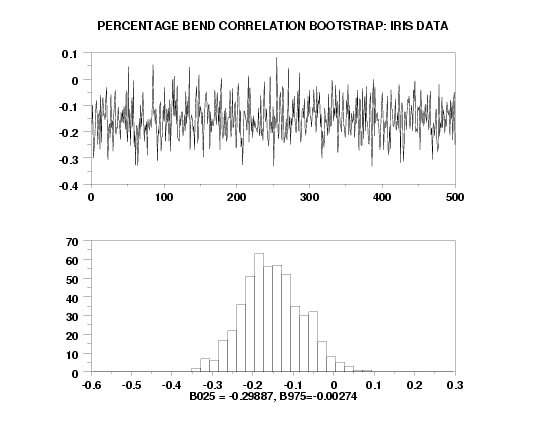

|
PERCENTAGE BEND CORRELATIONName:
Many statistics have one of these properties. However, it can be difficult to find statistics that are both resistant and have robustness of efficiency. The Pearson correlation coefficient is an optimal estimator for Gaussian data. However, it is not resistant and it does not have robustness of efficiency. The percentage bend correlation estimator, discussed in Shoemaker and Hettmansperger and also by Wilcox, is both resistant and robust of efficiency. The rationale and derivation for this estimate is given in these references. The percentage bend correlation between two variables X and Y is computed as follows:
The value of \( \beta \) is selected between 0 and 0.5. Higher values of \( \beta \) result in a higher breakdown point at the expense of lower efficiency.
<SUBSET/EXCEPT/FOR qualification> where <y1> is the first response variable; <y2> is the second response variable; <par> is a parameter where the computed percentage bend correlation is stored; and where the <SUBSET/EXCEPT/FOR qualification> is optional.
LET A = PERCENTAGE BEND CORRELATION Y1 Y2 SUBSET TAG > 2
where <value> is greater than 0 and less than or equal to 0.5. The default value for \( \beta \) is 0.1.
Rand Wilcox (1997), "Introduction to Robust Estimation and Hypothesis Testing", Academic Press. Mosteller and Tukey (1977), "Data Analysis and Regression: A Second Course in Statistics", Addison-Wesley, pp. 203-209.
SKIP 25
READ MATRIX IRIS.DAT Y1 Y2 Y3 Y4 X
LET M = CREATE MATRIX Y1 Y2 Y3 Y4
SET CORRELATION TYPE PERCENTAGE BEND
LET B = CORRELATION MATRIX Y1 Y2 Y3 Y4
Program 2:
SKIP 25
READ IRIS.DAT Y1 Y2 Y3 Y4 X
.
MULTIPLOT CORNER COORDINATES 0 0 100 95
MULTIPLOT SCALE FACTOR 2
MULTIPLOT 2 1
BOOTSTRAP SAMPLES 500
BOOTSTRAP PERCENTAGE BEND CORRELATION PLOT Y1 Y2
X1LABEL DISPLACEMENT 12
X1LABEL B025 = ^B025, B975=^B975
HISTOGRAM YPLOT
END OF MULTIPLOT
MOVE 50 96
JUSTIFICATION CENTER
TEXT PERCENTAGE BEND CORRELATION BOOTSTRAP: IRIS DATA

|
Privacy
Policy/Security Notice
NIST is an agency of the U.S.
Commerce Department.
Date created: 08/12/2002 | ||||||||||||||||||